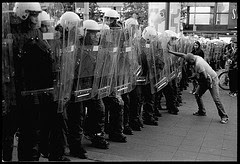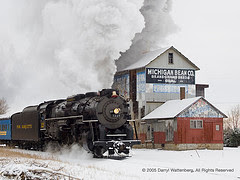Ever since I began teaching I have looked for my own common thread that I can weave into the content and through the semester. I teach American History and in our study of periods such as the Age of Innovation & Industrialism, The Age of Empire-Building, and the Great Depression I usually measure up the decisions of Americans against the ideals set forth in the Declaration of Independence. It works great for essays but usually draws blank stares after about the tenth time I ask them to tell me which ideals were expanded and which were impeded. The ideals are a great way to stir debate and get the students thinking but it lacks the concrete over-arching thread that I've been looking for. I have also tried trading cards for each unit, where students developed a large set of two or three trading cards (examples include WWI Doughboys, Teddy Roosevelt, Rough Riders, settlement houses) and then traded with classmates to complete a unit set. It is time-intensive and not so printer friendly. It only took a couple of gentle emails from parents about the draining of their computer ink wells for me to realize the cards were a great once-a-semester project...I was back to the drawing board.
At the end of the semester the World History teachers (I also teach World History) put their heads together to think of some creative and technological ways to connect the kids and the content. What we found were a number of ways that were fun, learner-centered and linked the content and technology. Among the ideas were a Renaissance "Talk Show" that students would film and place on youtube, a Facebook page for a World Explorer (like Magellan, de Sota, Christopher Columbus), and an Enlightenment blog. Great ideas for each unit, admittedly, but still not the overarching connection that I can lean on to culminate each unit. And then I remember how a veteran teacher down the hall ties-in each unit. He uses the free online publishing site lulu.com to help the students author a "stories through-out history" book of third-person historical accounts. The students spend time in the lab every other week and work with a partner to complete a two-page story that includes at least five key terms from the historical period and a story that weaves the author into that particular time in history. Apparently, after talking to him, the project is a great way to connect concepts and gives the class some finality at the end of the year. Students also come back to look at the finished product the next year and can even order their own edition from the lulu website.
I believe that each teacher needs to find their own niche. My veteran colleague has obviously found his system that works. And after listening to him and then connecting the dots I came up with an idea that just might work...
When I am not either teaching, coaching wrestling, lesson-planning, scouting or grading I enjoy reading either historical non-fiction and TIME magazines. I have "Team of Rivals" by Doris Kearns Goodwin and a copy of "High Hopes: From Purple to Pasadena" by Gary Barnett on my night stand. I trade off each night between the two. But my guilty pleasure when I have a moment edge-wise is a good old TIME magazine. I like that I can either read it cover to cover or I can pick and choose tiny articles on "the World" page or read about interesting perspectives in the editorials or just take-in the excellent, worldly photography. One night, while lamenting my need for an over-arching thread to the class my wife Amanda suggested have the students create a TIME magazine for each historical time period. That was a "light bulb" moment.
Immediately I took out a pen and paper to write down the basics...They would create a headline & cover page, a "Briefing Page", and my favorite the "Verbatim" page, provide editorials and feature articles detailing the large concepts of each time period. They would also create artistic renderings of the historical figures, battles and technological advancements of the time period.
The TIME magazine approach would allow individuals to work towards a team outcome. If I wanted to take it one step further, I could have the students interview for positions in their groups (this would include resumes, cover letters and references). The TIME magazine approach would integrate several classroom technologies including online textbooks, the use of internet resources, Microsoft Word & Publisher and if I wanted to take it to the next level, each group could maintain their own blog/website much like www.time.com. Tomorrow is the launch of this project that I hope will engage the students, draw upon several learning styles, encourage higher-order thinking like application, analysis, synthesis & evaluation (Bloom's taxonomy). I would create a literal library of TIME magazines through-out the ages. It would also serve as a great source of review for the students at the end of each semester. They could grab the issue from the time period they need to review and simply read the articles, look at the spotlight page or peruse verbatim.
I hope this is it. It looks like I might have a winner. I just might have my common thread.
Tuesday, February 2, 2010
Subscribe to:
Post Comments (Atom)




3 comments:
This sounds like a very exciting idea and it enables the students to make a very hands-on project while learning a lot in the process. The items that they use within their magazine will definitely stick with them over time and so I am sure that your goal for the students will be attained.
This is a great idea! Spouses always seem to come up with the best solutions don't they? Students would really enjoy creating their own magazine and publishing it. Sometimes the students get so involved in the creative part that they forget to incorporate the information from the rubric. How do you handle that situation?
Julie Simonsen
Are you going to share the results of this project with the class? I am very interested to see how it turns out, even if you have send me a summary (blog post) after our EDU 590 wraps. Sounds interesting and engaging.
Post a Comment